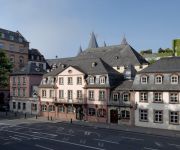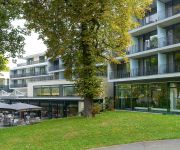Safety Score: 3,0 of 5.0 based on data from 9 authorites. Meaning we advice caution when travelling to Germany.
Travel warnings are updated daily. Source: Travel Warning Germany. Last Update: 2024-08-13 08:21:03
Touring Mainz-Oberstadt
The district Mainz-Oberstadt of Mainz in Rhineland-Palatinate is a subburb located in Germany about 283 mi south-west of Berlin, the country's capital place.
Need some hints on where to stay? We compiled a list of available hotels close to the map centre further down the page.
Being here already, you might want to pay a visit to some of the following locations: Gau-Bischofsheim, Klein-Winternheim, Bodenheim, Harxheim and Ginsheim-Gustavsburg. To further explore this place, just scroll down and browse the available info.
Local weather forecast
Todays Local Weather Conditions & Forecast: 11°C / 51 °F
| Morning Temperature | 10°C / 50 °F |
| Evening Temperature | 5°C / 41 °F |
| Night Temperature | 4°C / 40 °F |
| Chance of rainfall | 15% |
| Air Humidity | 82% |
| Air Pressure | 997 hPa |
| Wind Speed | Moderate breeze with 13 km/h (8 mph) from North-East |
| Cloud Conditions | Overcast clouds, covering 100% of sky |
| General Conditions | Heavy intensity rain |
Wednesday, 20th of November 2024
4°C (39 °F)
2°C (36 °F)
Snow, moderate breeze, few clouds.
Thursday, 21st of November 2024
3°C (38 °F)
1°C (33 °F)
Rain and snow, moderate breeze, clear sky.
Friday, 22nd of November 2024
4°C (40 °F)
3°C (37 °F)
Light snow, moderate breeze, broken clouds.
Hotels and Places to Stay
Hyatt Regency
Havana
Favorite Parkhotel
Hilton Mainz City
IntercityHotel
AC Hotel Mainz
Hilton Mainz
Novotel Mainz
INNdependence
Campo Novo Business mainz
Videos from this area
These are videos related to the place based on their proximity to this place.
Die Breite Masse | Rosenmontag in Mainz
a film by www.geralddietsch.com Mainz, Germany, Shrove Monday 2011 The Mainz procession on Shrove Monday took place for the first time in 1838. With some 9500 active participants and...
Rosenmontagszug in Mainz, Karneval 2015
Rosenmontag in Mainz - Helau! Kaiserstraße, Große Bleiche, Schillerplatz, Altstadt, Gutenbergplatz und mehr. Fasching, Karneval, Fastnacht - die 5. Jahreszeit wird gefeiert. :) Schwellköppe,...
Mainz, Rhineland Palatinate, Germany - 6th August, 2014
Mainz is the capital of the state of Rhineland-Palatinate in Germany. The city is located on the river Rhine at its confluence with the Main opposite Wiesbaden, in the western part of the Frankfurt...
Abschied von Jürgen Dietz in Mainz
Bei der Sitzung der Eiskalten Brüder in Alt Gunsenum hält Andreas Schmitt eine Abschiedsrede auf den gestorbenen Fastnachter Jürgen Dietz. Werdet ein Fan auf Facebook: https://www.facebook.com/ ...
Mainz: Gautschen beim Johannisfest.
Traditionell werden die fertigen Lehrlinge aus dem Druckgeschäft beim gautschen in eine Wasserbüt getaucht. Dabei sollen der Bleistaub und die Sünden ihrer Lehrjahre symbolisch abgewaschen...
Mainz in winter 2007-2008
Impressions of the winter season 2007 - 2008 in my home town Mainz, located on the river Rhine in Germany. Even a winter in Mainz has its sunny days! This is my inofficial contribution to the...
Taubertsbergbad Mainz - Turborutsche Onride
Onride-Video der Turborutsche im Taubertsbergbad Mainz. Mehr Infos und Bilder zum Taubertsbergbad Mainz gibt es unter ...
02/16 Mahnwache Mainz am Tag der Wahrheit 3. Okt. 2014
Dem Aufruf der Journalistin Eva Hermann an die "Mainstream"-Journalisten, wenigstens einen Tag lang einmal nur die Wahrheit zu berichten, folgten viele pflichtbewusste, Wahrheits-liebende ...
Mainz-Gustavsburg to Wiesbaden Hbf: Views from the S-Bahn S9, Germany - 8th August, 2014
This film features views from the S9 train on a short journey from Mainz-Gustavsburg to Wiesbaden Hauptbahnhof. The train crosses the rive rhine twice on this journey, firstly over the Eisenbrücke...
Mit der preussischen G8 zum Bahnhofsfest nach Mainz
125 Jahre Mainzer Hauptbahnhof und die Preussische G8 des Deutschen Museumseisenbahn aus Darmstadt Kranichstein fährt dorthin. Impressionen vom Weg dorthin direkt vom Führerstand. Die...
Videos provided by Youtube are under the copyright of their owners.
Attractions and noteworthy things
Distances are based on the centre of the city/town and sightseeing location. This list contains brief abstracts about monuments, holiday activities, national parcs, museums, organisations and more from the area as well as interesting facts about the region itself. Where available, you'll find the corresponding homepage. Otherwise the related wikipedia article.
Gutenberg Museum
The Gutenberg Museum is one of the oldest museums of printing in the world, located opposite the cathedral in the old part of Mainz, Germany. It is named after Johann Gutenberg, the inventor of printing from moveable metal type. The collections include printing equipment and examples of printed materials from many cultures.
Mainz Cathedral
Mainz Cathedral or St. Martin's Cathedral (in German Mainzer Dom, Martinsdom or - officially - Der Hohe Dom zu Mainz) is located near the historical center and pedestrianized market square of the city of Mainz, Germany. This 1000 year-old Roman Catholic cathedral is the site of the episcopal see of the Bishop of Mainz.
Mont-Tonnerre
Mont-Tonnerre is the name of a département of the First French Empire in present Germany. It is named after the highest point in the Rhenish Palatinate, the Donnersberg. It was the southernmost of four départements formed in 1798, when the west bank of the Rhine was annexed by France. Prior to the French occupation, its territory was divided between the Archbishopric of Mainz, the Bishopric of Speyer and the Electorate of the Palatinate.
Mainz Central Station
Mainz Central Station (Mainz Hauptbahnhof) is a railway station for the city of Mainz in the German state of Rhineland-Palatinate. It is used by about 80,000 travelers and visitors each day and is therefore by far the busiest station in Rhineland-Palatinate. The station was a trial area for a CCTV scheme using automated face recognition.
Deutschhaus Mainz
The Deutschhaus or Deutschordenskommende is a historical building in Mainz, western Germany, which is the seat of the Rhineland-Palatinate Landtag.
Mainz Citadel
The Mainzer Zitadelle is situated at the fringe of the Old Town near Mainz Römisches Theater station. The fortress was constructed in 1660 and was an important part of the Fortress Mainz.
Electoral Palace, Mainz
The Electoral Palace in Mainz (German: Kurfürstliches Schloss zu Mainz) is the former city Residenz of the Archbishop of Mainz, who was also Prince-Elector of his electoral state within the Holy Roman Empire. It is one of the important Renaissance buildings in Germany.
St. Stephen's Church, Mainz
The Collegiate Church of St. Stephan, known in German as St. Stephan zu Mainz, is a Gothic hall collegiate church located in the German city of Mainz.
Walk of Fame of Cabaret
The Walk of Fame of Cabaret is a sidewalk between Proviant-Magazin and Schönborner Hof in Mainz, Germany, which is embedded with more than 40 seven-pointed irregularly shaped stars featuring the names of cabaret celebrities selected by a group of experts and honored by several sponsors for their contributions to the cabaret culture.
Jupiter Column
A Jupiter Column (German: Jupitergigantensäule or Jupitersäule) is an archaeological monument belonging to a type widespread in Roman Germania. Such pillars express the religious beliefs of their time. They were erected in the 2nd and 3rd centuries AD, mostly near Roman settlements or villas in the Germanic provinces. Some examples also occur in Gaul and Britain.
Bassenheimer Hof
The Bassenheimer Hof (Bassenheimer Palace) is an historic building in Mainz, western Germany. At present (2009) the large structure is the seat of the Ministry of the Interior and Sports of the federal state of Rhineland-Palatinate.
St. Alban's Abbey, Mainz
St. Alban's Abbey, Mainz (Stift St. Alban vor Mainz) originated as a Benedictine abbey, founded in 787 or 796 by Archbishop Richulf (787–813) in honour of Saint Alban of Mainz, located to the south of Mainz on the hill later called the Albansberg. It was turned into a collegiate foundation (Herrenstift) in 1442. The buildings were entirely destroyed in 1552, although the foundation retained a legal existence until its formal dissolution in 1802.
Osteiner Hof
The Osteiner Hof ("Court of Ostein") is one of several Baroque-era palatial mansions along Schillerplatz square in the German city of Mainz. The mansion, along the southern edge of the square, was built in 1747-1752 by architect-soldier Johann Valentin Thomann for Franz Wolfgang Damian von Ostein, brother of Johann Friedrich Karl von Ostein, who was prince-bishop of Mainz at that time.
Fortress of Mainz
The Fortress of Mainz was a fortressed garrison town between 1620 and 1918. At the end of the Napoleonic Wars, under the term of the 1815 Peace of Paris, the control of Mainz passed to the German Confederation and became part of a chain of strategic fortresses which protected the Confederation with the dissolution of the Confederation control of the fortress passed to the German Empire.
Catholic University of Applied Sciences Mainz
The Catholic University of Applied Sciences Mainz (German Katholische Hochschule Mainz) is a university located in Mainz, Germany. It was founded in 1972.
Landesmuseum Mainz
The Landesmuseum Mainz, or Mainz State Museum, is a museum of art and history in Mainz, Germany. In March 2010 it reopened in full after an extensive renovation. The museum has its roots in a painting collection donated by Napoleon and Chaptal to the city of Mainz in 1803. It moved into its current location, in the former electoral stables, in 1937, by which time it had grown significantly. It received its present name in 1986, and was renovated and modernised from 2004 to 2010.
Romano-Germanic Central Museum (Mainz)
The Romano-Germanic Central Museum (German: Römisch-Germanisches Zentralmuseum) is an archaeological and historical research institution for pre-history and early history headquartered in Mainz. It is supported by the Federal Republic of Germany and its states and is a member of the Leibniz Association of German research institutions. The institution studies the Old World and its contact zones from the Stone Age to the Middle Ages.
Iron Tower
The Iron Tower is a mediaeval tower dating to the early 13th century, and modified in the 15th century, which with the Wood Tower and the Alexander Tower is one of three remaining towers from the city walls of Mainz, Germany. Its name derives from the Iron Market (Eisenmarkt), which was held in the immediate vicinity until the 19th century. The Iron Tower served as a watchtower and gate to the city, and later as a gaol. It was badly damaged in World War II and reconstructed in the 1960s.
Wood Tower
The Wood Tower is a mediaeval tower in Mainz, Germany, with the Iron Tower and the Alexander Tower one of three remaining towers from the city walls. Its current Gothic appearance dates to the early 15th century. It is so named because wood used to be piled next to it on the bank of the Rhine. Like the Iron Tower, the Wood Tower was used as a watchtower and gate-tower and later as a gaol.
Christuskirche, Mainz
The Christuskirche (Christ Church) is a Protestant church located in Mainz. The Christuskirche was built between 1896 and 1903 designed by Eduard Kreyßig. It was consecrated on 2 July 1903. After demolition during the air raids of World War II the church was reconstructed between 1952 and 1954. In the predominantly Catholic Mainz of 1802, only some hundred Protestants could be traced at the end of the Ancien Régime.
Trams in Mainz
The Mainz tramway network forms part of the public transport system in Mainz, the capital city of the federal state of Rhineland-Palatinate, Germany. Opened in 1883, the network has been operated since 2001 by Mainzer Verkehrsgesellschaft (MVG).
Rabanus-Maurus-Gymnasium
The Rabanus-Maurus-Gymnasium is a classical gymnasium school in the Neustadt district of Mainz.
Drususstein
The Drususstein (Drususstone) is a nearly 20 meters high, masonry block of Roman origin on the grounds of the citadel of Mainz, Germany. It was originally cast in marble. Researchers now largely accept that this is the structural remnant of the cenotaph mentioned by writers like Eutropius and Suetonius, erected in 9 BC by Roman troops in honour of the deceased general Drusus, in Mogontiacum.
Mainz Römisches Theater station
Mainz Römisches Theater station is a station in the city of Mainz, the capital of the German state of Rhineland-Palatinate on the Main Railway from Mainz to Frankfurt am Main. It is the most important station in the city after Mainz Hauptbahnhof. It is classified by Deutsche Bahn as a category 3 station. The station is served by S-Bahn and regional trains.
Marktbrunnen (Mainz)
The Marktbrunnen in Mainz is a renaissance fountain located at the ″Markt″ (market place) of Mainz. It was donated by elector Albert of Mainz and crafted in the workshop of the Mainz sculpturer Hans Backoffen. The Marktbrunnen represents one of the first architectural formed decorated fountains of the renaissance.




























